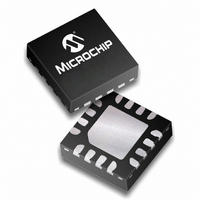PIC16F688-E/ML Microchip Technology, PIC16F688-E/ML Datasheet - Page 101

PIC16F688-E/ML
Manufacturer Part Number
PIC16F688-E/ML
Description
IC PIC MCU FLASH 4KX14 16QFN
Manufacturer
Microchip Technology
Series
PIC® 16Fr
Datasheets
1.PIC16F616T-ISL.pdf
(8 pages)
2.PIC16F688T-ISL.pdf
(204 pages)
3.PIC16F688T-ISL.pdf
(6 pages)
4.PIC16F688T-ISL.pdf
(4 pages)
5.PIC16F688T-ISL.pdf
(688 pages)
Specifications of PIC16F688-E/ML
Core Size
8-Bit
Program Memory Size
7KB (4K x 14)
Core Processor
PIC
Speed
20MHz
Connectivity
UART/USART
Peripherals
Brown-out Detect/Reset, POR, WDT
Number Of I /o
12
Program Memory Type
FLASH
Eeprom Size
256 x 8
Ram Size
256 x 8
Voltage - Supply (vcc/vdd)
2 V ~ 5.5 V
Data Converters
A/D 8x10b
Oscillator Type
Internal
Operating Temperature
-40°C ~ 125°C
Package / Case
16-QFN
Controller Family/series
PIC16F
No. Of I/o's
12
Eeprom Memory Size
256Byte
Ram Memory Size
256Byte
Cpu Speed
20MHz
No. Of Timers
2
Processor Series
PIC16F
Core
PIC
Data Bus Width
8 bit
Data Ram Size
256 B
Interface Type
EUSART, RS- 232, SCI, USB
Maximum Clock Frequency
20 MHz
Number Of Programmable I/os
12
Number Of Timers
2
Maximum Operating Temperature
+ 125 C
Mounting Style
SMD/SMT
3rd Party Development Tools
52715-96, 52716-328, 52717-734
Development Tools By Supplier
PG164130, DV164035, DV244005, DV164005, PG164120, ICE2000, DM163014, DM164120-4
Minimum Operating Temperature
- 40 C
On-chip Adc
10 bit, 8 Channel
Lead Free Status / RoHS Status
Lead free / RoHS Compliant
For Use With
AC164324 - MODULE SKT FOR MPLAB 8DFN/16QFNXLT16QFN1 - SOCKET TRANSITION 14DIP TO 16QFNAC162061 - HEADER INTRFC MPLAB ICD2 20PINAC162056 - HEADER INTERFACE ICD2 16F688
Lead Free Status / Rohs Status
Details
- PIC16F616T-ISL PDF datasheet
- PIC16F688T-ISL PDF datasheet #2
- PIC16F688T-ISL PDF datasheet #3
- PIC16F688T-ISL PDF datasheet #4
- PIC16F688T-ISL PDF datasheet #5
- Current page: 101 of 688
- Download datasheet (3Mb)
6.2.6
1997 Microchip Technology Inc.
Program Memory Paging
Some devices have program memory sizes greater then 2K words, but the CALL and GOTO
instructions only have a 11-bit address range. This 11-bit address range allows a branch within
a 2K program memory page size. To allow CALL and GOTO instructions to address the entire 1K
program memory address range, there must be another two bits to specify the program memory
page. These paging bits come from the PCLATH<4:3> bits
GOTO instruction, the user must ensure that page bits (PCLATH<4:3>) are programmed so that
the desired program memory page is addressed
tions is executed, the entire 13-bit PC is POPed from the stack. Therefore, manipulation of the
PCLATH<4:3> is not required for the return instructions.
Example 6-1
assumes that PCLATH is saved and restored by the interrupt service routine (if interrupts are
used).
Example 6-1: Call of a Subroutine in Page1 from Page0
SUB1_P1:
Note:
ORG 0x500
BSF
CALL
ORG 0x900
RETURN
:
:
:
Section 6. Memory Organization
Devices with program memory sizes 2K words and less, ignore both paging bits
(PCLATH<4:3>), which are used to access program memory when more than one
page is available. The use of PCLATH<4:3> as general purpose read/write bits (for
these devices) is not recommended since this may affect upward compatibility with
future products.
Devices with program memory sizes between 2K words and 4K words, ignore the
paging bit (PCLATH<4>), which is used to access program memory pages 2 and 3
(1000h - 1FFFh). The use of PCLATH<4> as a general purpose read/write bit (for
these devices) is not recommended since this may affect upward compatibility with
future products.
shows the calling of a subroutine in page 1 of the program memory. This example
PCLATH,3
SUB1_P1
; Select Page1 (800h-FFFh)
; Call subroutine in Page1 (800h-FFFh)
;
;
;
; called subroutine Page1 (800h-FFFh)
;
; return to Call subroutine in Page0 (000h-7FFh)
;
(Figure
6-2). When one of the return instruc-
(Figure
6-2). When doing a CALL or
DS31006A-page 6-7
6
Related parts for PIC16F688-E/ML
Image
Part Number
Description
Manufacturer
Datasheet
Request
R

Part Number:
Description:
Manufacturer:
Microchip Technology Inc.
Datasheet:

Part Number:
Description:
IC PIC MCU FLASH 4KX14 14SOIC
Manufacturer:
Microchip Technology
Datasheet:

Part Number:
Description:
IC MCU FLASH 4KX14 14TSSOP
Manufacturer:
Microchip Technology
Datasheet:

Part Number:
Description:
IC PIC MCU FLASH 4KX14 14DIP
Manufacturer:
Microchip Technology
Datasheet:

Part Number:
Description:
IC PIC MCU FLASH 4KX14 16QFN
Manufacturer:
Microchip Technology
Datasheet:

Part Number:
Description:
IC MCU PIC FLASH 4KX14 14SOIC
Manufacturer:
Microchip Technology
Datasheet:

Part Number:
Description:
IC PIC MCU FLASH 4KX14 14TSSOP
Manufacturer:
Microchip Technology
Datasheet:

Part Number:
Description:
IC MCU PIC FLASH 4KX14 14DIP
Manufacturer:
Microchip Technology
Datasheet:

Part Number:
Description:
IC PIC MCU FLASH 4KX14 14TSSOP
Manufacturer:
Microchip Technology
Datasheet:

Part Number:
Description:
IC, 8BIT MCU, PIC16F, 32MHZ, SOIC-18
Manufacturer:
Microchip Technology
Datasheet:

Part Number:
Description:
IC, 8BIT MCU, PIC16F, 32MHZ, SSOP-20
Manufacturer:
Microchip Technology
Datasheet:

Part Number:
Description:
IC, 8BIT MCU, PIC16F, 32MHZ, DIP-18
Manufacturer:
Microchip Technology
Datasheet:

Part Number:
Description:
IC, 8BIT MCU, PIC16F, 32MHZ, QFN-28
Manufacturer:
Microchip Technology
Datasheet:

Part Number:
Description:
IC, 8BIT MCU, PIC16F, 32MHZ, QFN-28
Manufacturer:
Microchip Technology
Datasheet:

Part Number:
Description:
IC, 8BIT MCU, PIC16F, 32MHZ, QFN-28
Manufacturer:
Microchip Technology
Datasheet:










